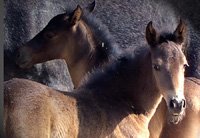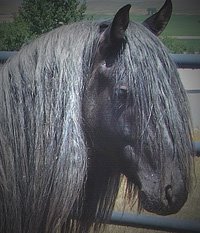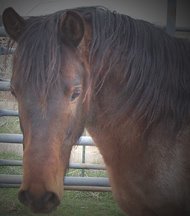Acey also possesses an obvious emotional barometer. All horses are honest, of course, but Acey waves her emotions like a flag. She tightens her chin at onset of the slightest tension, stretches her upper lip when scratched, calmly accepts new but carefully introduced stimuli...and doesn't hesitate to bolt from perceived danger.
This last tendency has resulted in a few incidents in which a panicky Acey pulled the lead from my hands and made a run for it. I really hate for this to happen, not least because I'd prefer a horse never learn that it is capable of escaping its handler. It also makes me quite sure that I need to do more work with Acey before taking her for walks around the fields where our first rides will occur -- hopefully by the end of June.
my hands and made a run for it. I really hate for this to happen, not least because I'd prefer a horse never learn that it is capable of escaping its handler. It also makes me quite sure that I need to do more work with Acey before taking her for walks around the fields where our first rides will occur -- hopefully by the end of June.
 my hands and made a run for it. I really hate for this to happen, not least because I'd prefer a horse never learn that it is capable of escaping its handler. It also makes me quite sure that I need to do more work with Acey before taking her for walks around the fields where our first rides will occur -- hopefully by the end of June.
my hands and made a run for it. I really hate for this to happen, not least because I'd prefer a horse never learn that it is capable of escaping its handler. It also makes me quite sure that I need to do more work with Acey before taking her for walks around the fields where our first rides will occur -- hopefully by the end of June.Problems like this make me glad that I keep careful notes regarding my training sessions. When training four to six horses at any given time, it's easy to forget (or mis-remember) exactly how much time I've spent on a particular lesson with a particular horse. I checked my notes from last year, and sure enough, Acey hasn't done nearly enough direction-change work on the lunge.
This simple exercise is well described in Charles Wilhelm's book Building Your Dream Horse. It involves moving the horse in a circle around the handler and frequently asking the horse to make inside turns to change direction. The benefits of the exercise are myriad:
1) The horse learns to give to pressure.
2) The horse learns to bend.3) Once learned, the exercise can be used to satisfy a spooked horse's flight instinct while keeping him focused on the handler.
4) Once learned, the exercise can do anything from entertaining a bored horse during a long wait to putting a misbehaving horse to work.
It goes almost without saying that a horse conditioned to turn toward the handler in response to pressure on the halter will be much less likely to break loose in a panic situation.
Normally, I do this exercise using a 10-foot lead rope. Acey, however, seemed to find that method too high-pressure. She pulled against me and sped up so that I couldn't effectively "bump" her back toward me rather than allowing her to continue pulling. Before she could form a bad habit of pulling, I switched to a soft, cotton lunge line instead. Doing so gave her more space and let the round corral keep her from pulling to the outside so we could both focus on direction changes.
Normally, I do this exercise using a 10-foot lead rope. Acey, however, seemed to find that method too high-pressure. She pulled against me and sped up so that I couldn't effectively "bump" her back toward me rather than allowing her to continue pulling. Before she could form a bad habit of pulling, I switched to a soft, cotton lunge line instead. Doing so gave her more space and let the round corral keep her from pulling to the outside so we could both focus on direction changes.
 At first, she was nervous and resistant. I had to use dramatic body language (backing away and turning my "center" to close the door forward), significant halter pressure, and an occasional flick of the whip to get Acey through the initial direction changes.
At first, she was nervous and resistant. I had to use dramatic body language (backing away and turning my "center" to close the door forward), significant halter pressure, and an occasional flick of the whip to get Acey through the initial direction changes. After a few repetitions, however, she settled into the exercise and responded to a much lighter touch.
After a few repetitions, however, she settled into the exercise and responded to a much lighter touch. 
We also reviewed some other give-to- pressure exercises. This one, which I also use to train a horse to tie, involves asking the horse to follow pressure from a long rope looped around a solid object, even though I am moving in a different direction. (Note: Do not attempt this with standard, 16-gauge panels! Our round corral panels are 7 foot high, 12-gauge steel locked together at the top so they cannot be pulled more than about 12 inches inward, even by a panicking horse.)
 This exercise, which I normally use to introduce a very green horse to the idea of the handler dis- appearing from one side of his hindquarters and reappearing on the other side, involves looping the lead rope around the hindquarters, standing on the horse's opposite side, and asking the horse to follow the halter pressure around to face me. (Obviously, the horse in question should be comfortable with having ropes around its hind legs before attempting this maneuver.)
This exercise, which I normally use to introduce a very green horse to the idea of the handler dis- appearing from one side of his hindquarters and reappearing on the other side, involves looping the lead rope around the hindquarters, standing on the horse's opposite side, and asking the horse to follow the halter pressure around to face me. (Obviously, the horse in question should be comfortable with having ropes around its hind legs before attempting this maneuver.)Just because Acey is learning responsiveness to the halter in the safe, familiar round corral doesn't mean she'll remain responsive out in the big, scary world. Before taking her out, I need to teach her to respond even under stress. I'll do this by intentionally increasing her emotional level in the round corral, then asking her to work through the stress.
How? By asking her to perform the familiar give-to-pressure exercises with a rope dangling around her gaskins, while trotting over a tarp or poles, with plastic bags tied to her tack, etc.
How? By asking her to perform the familiar give-to-pressure exercises with a rope dangling around her gaskins, while trotting over a tarp or poles, with plastic bags tied to her tack, etc.
These are fun lessons that serve to build the horse's confidence and the trainer-trainee relationship. Acey will learn to trust me and respond to my instructions despite being under stress, and I will learn her typical stress responses and how best to mitigate them.
Only then will Acey be ready to really break free.








2 comments:
I never really thought about keeping notes about training sessions. Looking back, I'm wishing I had.
I do find my notes come in handy, especially after training has been suspended for a couple months over the winter. I use and Excel spreadsheet to keep track of plans and progress for each horse. I wrote more about my Training Tracker in the March 2008 post entitled "Of Lions and Lambs."
Post a Comment